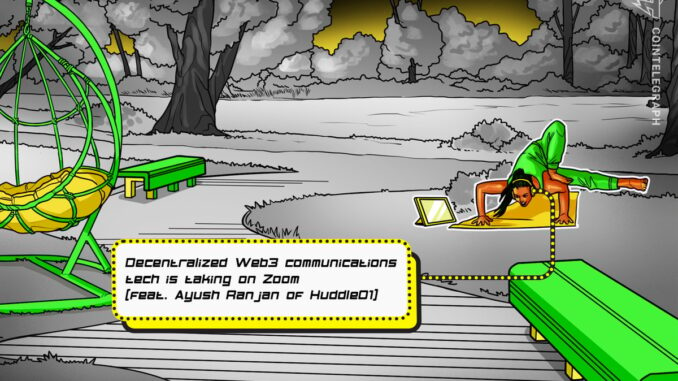
[ad_1]
The means by which humans communicate and coordinate are ever-evolving. People went from sending smoke signals and messengers on horseback to sending letters and telegrams, and since the dawn of the digital era, the pace of innovation has exploded.
Today, hundreds or even thousands of people from around the world can gather in a Twitter Space or Zoom call and communicate in practically real-time. But people still primarily communicate via centralized platforms that retain and monetize user data, suffer from outages, have the power to censor speech, and face problems such as severe lag.
So, what would a decentralized Web3 version of a communications and meeting platform like Zoom or Google Meet look like? To find out, Jonathan DeYoung and Ray Salmond sat down with Ayush Ranjan, co-founder and CEO of Huddle01 — a Web3 meetings and communications platform — on Episode 24 of The Agenda podcast.

The problem with centralized communications
Huddle01 offers a built-in set of Web3-native tools people can use when planning their meetings. For example, users can connect their wallets and use their nonfungible token (NFT) profile pictures as avatars, and meetings can be token-gated. In addition, video recordings can be stored on the InterPlanetary File System. However, according to Ranjan, the company’s core focus is to make communications and coordination easier and more reliable through decentralization.
The major problem with tools such as Zoom is that they are “built with a very top-down approach,” meaning that every call from all around the world is routed through centralized servers. “Let’s suppose we are doing a call in India,” Ranjan posited. “The calls are still routed through a central server in North Virginia. That means all the audio and video packets are routed all the way from India to the U.S., and then coming back via speed of light via the [fiberoptic] cables. The more distance it travels, it leads to latency. It leads to jitter and buffer, and that’s why you get these robotic voices.”
For the last 2 years we’ve heavily prioritized on team building to make the moonshot a reality.
Bringing a world class real-time communication application and infrastructure to you.
We are @huddle01com. pic.twitter.com/1LKkE2IDC4
— Ayush Ranjan FILBangalore’23 (@ranjan3118) August 21, 2022
Ranjan shared that during the height of the COVID-19 pandemic in India, when schooling went remote, his cousin could barely participate in his Zoom-based classes due to the extreme latency he experienced:
“That made me realize how big a problem this is. Like if your three years of education can go completely bite down the dust just because your infrastructure is not ready, we need to change this.”
This inspired him to co-found Huddle01, which he said can achieve significantly better performance by routing traffic through a distributed set of servers rather than one centralized location.
Which comes first: Decentralization or a good product?
Today, Huddle01 relies on Amazon Web Services, but its end goal is to transition to a fully decentralized protocol where individuals can run their own nodes (and get paid for it) through which call traffic will be routed.
Ranjan described this process as progressive decentralization. “We have followed an approach of solving demand first and then solving the supply side of things,” said the co-founder. “Instead of completely decentralizing the whole tech on day one itself, launching a network on day one itself, we are making sure that we do it progressively.”
He told The Agenda that because Huddle01 has focused on the user experience first, it has already clocked 2 million minutes of call time, meaning there will, theoretically, be guaranteed demand once the protocol actually goes live.
“If you do it decentralized from day one, will that lead to users not using it because it’s so tough to use?”
To hear more from Ranjan’s conversation with The Agenda — including how Huddle01 works with the Lens Protocol to empower creators, how it handles user privacy and its future plans for interplanetary communications — listen to the full episode on Cointelegraph’s Podcasts page, Apple Podcasts or Spotify. And don’t forget to check out Cointelegraph’s full lineup of other shows!
Magazine: I spent a week working in VR. It was mostly terrible, however…
This article is for general information purposes and is not intended to be and should not be taken as legal or investment advice. The views, thoughts, and opinions expressed here are the author’s alone and do not necessarily reflect or represent the views and opinions of Cointelegraph.
[ad_2]
Source link




